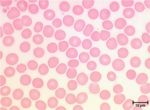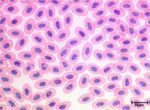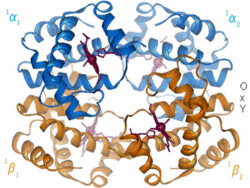Erythrocytes
| This article is still under construction. |
Commonly called red blood cells (RBCs)
Erythrocytes deliver oxygen to, and remove carbon dioxide from tissues.
Development
Erythrocytes are derived from the stem cell (CFU-GEMM) and formed in a process known as erythropoiesis.
Structure
Mammals
Erythrocytes are small (4-8µm), circular, anucleate biconcave cells that lack organelles.
The cell's membrane is a lipid bilayer which contains two different protein groups. Integral membrane proteins, which make up most of the proteins, and peripheral membrane proteins. The arrangement of these proteins makes the membrane elastic but stable and contributes towards the biconcave shape.
The biconcave shape increases the cell's surface area by 20-30% .
Birds
In birds erythrocytes are ovoid and contain a nucleus.
Haemoglobin
Or hemoglobin. Shortened to Hb
Haemoglobin is a metalloprotein that binds oxygen reversibly and accounts for almost all of the protein in the erythrocyte.
When bound to oxygen it is referred to as oxyhaemoglobin and when unbound, deoxyhaemoglobin. Haem gives blood its colour, and this colour depends on its saturation. When fully saturated with four oxygen molecules it appears red and when completely unsaturated it appears blue-red.
Haemoglobin also acts as an extracellular buffer
- Hb(O2)H + H2 ↔ Hb(O2)- + H3O+
- pKa = 6.6
- HbH + H2O ↔ Hb- + H3O+
- pKa = 7.8
Structure
It is composed of globin and four haem groups.
Globin
Globin is composed of two polypeptide groups each composed of two polpeptides chains. The chains are identical within the group, but differ between the groups. Globin varies between species and individuals within a species due to changes in the polypeptide chain sequence.
Haem
Each of the haem groups has an iron atom at its centre and each iron atom binds one molecule of oxygen. Haem groups are identical in all species.
Types
There are three types of haemoglobin: embryonic, fetal and adult. Embryonic is present in the early stages of fetal development. Fetal haemoglobin has a higher affinity for oxygen than adult haemoglobin and is replaced by adult haemoglobin shortly after birth. Dogs do not have fetal or embryonic haemoglobin. Horses do not have embryonic haemoglobin and their fetal haemoglobin is structurally identical to adult haemoglobin and as such some would say that there is no fetal haemoglobin. Pig (and horse) fetal haemoglobin has the same affinity for oxygen as their adult haemoglobin.
Figures
- One gram of haemoglobin binds 1.34g of oxygen.
- Haemoglobin concentration (g/l) varies between species
- Poultry: 90
- Ruminants: 100-120
- Dogs: 150
Antigens
Functions
Oxygen transport
Carbon dioxide transport
Degradation
Erythrocytes have a limited life span and as they age their membranes become more fragile leading to a loss of function and swelling. Damage occurs as the fragile cells pass through narrow capillaries which occurs particularly in the spleen. Ageing also causes sialic acid to be lost from the membrane and this exposes galactose moieties leading to phagocytosis.
Life Span
The life span of the erythrocyte varies from 70-160 days in the domestic species although the life span is often shorter in the juvenile animals (e.g. calves and lambs) than the adult. Small animal’s erythrocytes have a shorter life span than the larger domestic species.
| Life span (days) | ||||||
|---|---|---|---|---|---|---|
Cat
|
Pig
|
Dog
|
Goat
|
Horse
|
Sheep
|
Cattle
|
70
|
85
|
120
|
125
|
145
|
150
|
160
|
Transfused dog erythrocytes last around 21 days
Breakdown
Around 90% of erythrocytes are phagocytised by macrophages in the liver, spleen and bone marrow, with the other 10% breaking down in circulation.
Following phagocytosis, haemoglobin is broken down into haem and globin. Globin, a protein, is hydrolysed into amino acids while the haem is transformed into biliverdin and then into bilirubin before being excreted into the blood stream bound to albumin. In the liver it is conjugated and excreted into bile which in turn is excreted into the gut. The iron from haem is either stored as insoluble ferritin in the liver (hepatocytes and macrophages) or is directly transported to the bone marrow by transferring for reuse in erythropoiesis.



